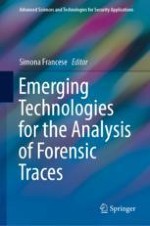2019 | OriginalPaper | Chapter
3. Novel Technological Applications for Latent and Blood-Stained Fingermark Aging Studies
Authors : Josep De Alcaraz-Fossoul, Meez Islam
Published in: Emerging Technologies for the Analysis of Forensic Traces
Publisher: Springer International Publishing
Activate our intelligent search to find suitable subject content or patents.
Select sections of text to find matching patents with Artificial Intelligence. powered by
Select sections of text to find additional relevant content using AI-assisted search. powered by
